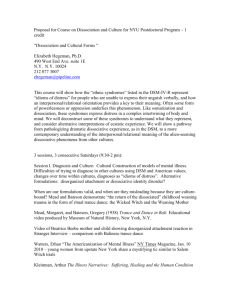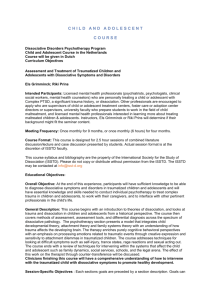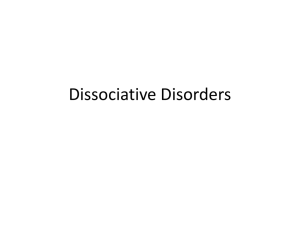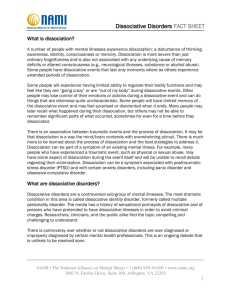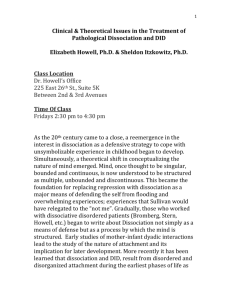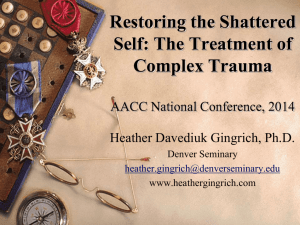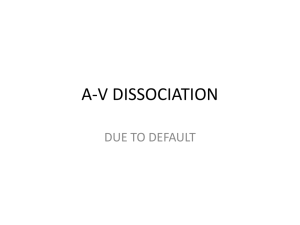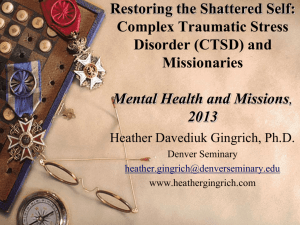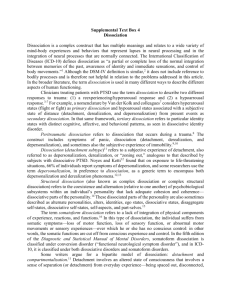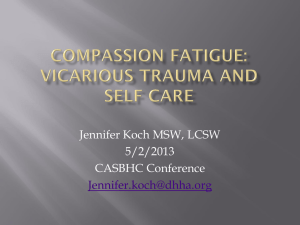Building Attachment Across States - Association for Treatment and
advertisement
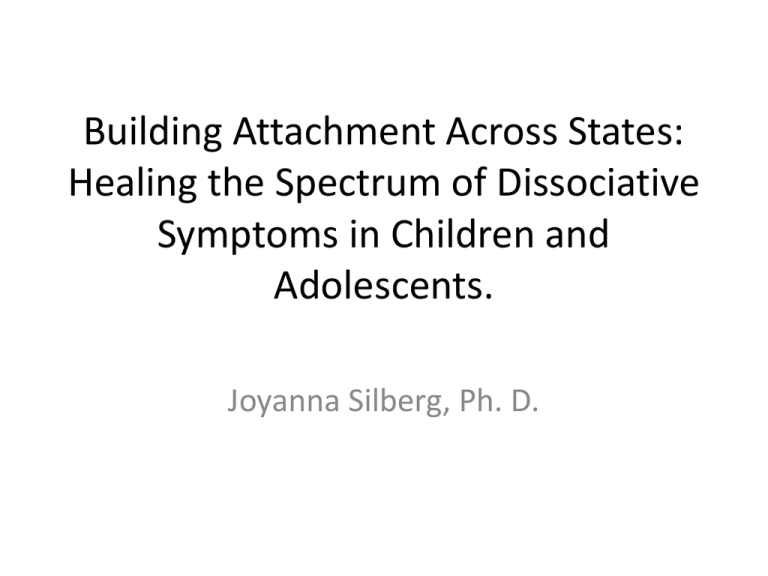
Building Attachment Across States: Healing the Spectrum of Dissociative Symptoms in Children and Adolescents. Joyanna Silberg, Ph. D. Dissociation Disruption in the usually integrated functions of consciousness, memory, identity or perception. When your inner life is a place you have to stay out of, having an identity is impossible. Remembering not to remember, fractures you. Lynda Barry, One Hundred Demons, 2002 I try to forget to remember. It hurts to remember. It gives me bad dreams. 6 year old Billy when asked about sexual abuse. Funny, though how much energy it takes in the present to avoid making sense of the past. Martin Moran Adina’s description of dissociation • It’s like a brain seizure. Your brain does this so don’t have thoughts, and you don’t know what’s going on. My face was smiling but my brain was crying. Adina, after a supervised visit. Why is this definition inadequate? • What is normal? • How do these functions really develop? • Must take into account what we know about neurobiological development. • Doesn’t explain how the disruption happens. What neurophysiological affects of trauma lead to dissociation? • Excessive activation of amygdala • Suppression of activity in left prefrontal cortex: observing ego • Underdevelopment of right orbitofrontal cortex, ability to self-regulate • Decreased hippocampal volume: Putting experience into chronology • Underdeveloped corpus collosum:disintegration of left and right • Decreased serotonin: mood is dsyregulated. At each moment the state of the self is constructed from the ground up. . . So continuously and consistently reconstructed that the owner never knows it is being remade unless something goes wrong with the remaking. Antonio Damasaio Insights from Putnam’s Discrete Behavioral States Theory • States become increasingly flexible through development. • Fear-based states are rigid and resistant to change. • The child’s relationship with a loving caregiver helps to regulate emotional states. Affect Theory Awareness and expression of feelings are the tools which build healthy consciousness. Tomkins Nine Innate Affects Interest—excitement Enjoyment-Joy Surprise-startle Fear-terror Distress-anguish Anger-Rage Shame-Humiliation Dissmell Disgust Affect is an amplifier. It either makes good things better or bad things worse. Tomkins, affect theory Affect is the “psychic glue” of consciousness and identity. “So complex and pervasive are habits of script formation that we live more within these personal scripts for the modulation and detoxification of affect than in the world of innate affect.” Nathanson, 1992 Interpersonal Neurobiology Key Insights From Interpersonal Neurobiology The mind is a regulater. Transitions between states are key moments when the self is built. Interpersonal processes shape the mind. “The mind is a system for regulating the flow of energy.” Daniel Siegel “Who you are is what you let in and what you keep out.” The mind works on data as a sculptor works on stone. The statue stood there from eternity but there were thousand different ones beside it. And the sculptor alone is to thank for having extricated this one from the rest. By slowly cumulative strokes of choice we have extracted the real world by simply rejecting portions of the given stuff. William James The brilliance of the mind lay in what is discarded not what is retained. Tor Norretranders It is at the moments of transition that new self- organizational forms can be constructed. Indeed, integrating coherence of the mind is about state shifts.” Daniel Siegel, The Developing Mind The mind emerges from the activity of the brain whose structure and function are directly shaped by interpersonal experience.” Daniel Siegel, The Developing Mind Dissociative shifts in a child create reciprocal states in caregivers and therapists. Children encode contradictory parental behaviors and messages and realities, and represent environmental dissociation within. How might a pathological environment inhibit the development of the mind? “Lies, deceptions and other sources of seriously distorted family interaction cause the growing child to exclude new and potentially meaningful information from communication and therefore from semantic processing and from conscious thought.” G. Liotti Healthy attachment promotes integrated functioning by allowing the child to to grow with freedom to trust emotional information. Unsoothed Trauma Destroys Relationships • Trauma Disrupts the Integration of experience of others because child learns people cannot be counted on, no soothing is possible. A Healthy Mind. . . Effectively selects the information that will allow Seamlessly managing the transitions between states, between affects, between contexts, and between developmental challenges in a way that is Adaptive to each shifting environmental demand. In the normal brain affect is a signal for memory retrieval, approach or avoidance action plans, assessment and reorganiztion. In the dissociative brain, affect is a signal of avoidance, memory loss, initiation of nonconscious action plans, and disorganization. So what happens if the mind has organized itself around the idea of avoiding the experience of innate affect, and substituting practiced patterns of behavior, and relating, automatically triggered by environmental cues? Dissociative behavior and accompanying symptoms. New Definition of Dissociation: The Automatic Activation of Patterns of Actions, Thought, Perception, Identity, or Affect which are overlearned and conditioned avoidance responses to traumatic cues and emotions. It’s like you’re on autopilot and someone else is controlling the switches. In the dissociative brain, affect is a signal of avoidance, memory loss, initiation of nonconscious action plans, and disorganization. So what happens if the mind has organized itself around the idea of avoiding the experience of innate affect, and substituting practiced patterns of behavior, and relating, automatically triggered by environmental cues? Dissociative behavior and accompanying symptoms. New Definition of Dissociation: The Automatic Activation of Patterns of Actions, Thought, Perception, Identity, or Affect which are overlearned and conditioned avoidance responses to traumatic cues and emotions. A short synthesis of the Affect Avoidance Theory of Dissociation Brain learns not to feel. Emotions are stimuli for avoidance, not processing and integration. Brain becomes organized around the principle of dissociation: Can’t know, can’t feel, can’t bond. Disintegration, Fragmentation, Rigid Dichotomies become the norm, not integration, flexible adaptation, seamless transitions. Dissociative behavior span a spectrum of severity. Key Implication of this theory of dissociation • Interaction with a loving caregiver who amplifies and validates affect, understands triggers, and helps regulate the child’s overwhelming feelings REVERSES DISSOCIATIVE PROCESSES. For Example: • Stimulation of unintegrated emotionally laden memory: Sonya breaks her bed • Switch to combative personality under stress: Brian lets Deep Anger cut up the Persian rug • Affect is cue to self harm to regulate intensity: Sally cuts herself in tranced out state. • Scolding from parents triggers inner world of imagination that takes salience over current world. (Gabrielle goes to the world of Gabrielle 6) Sonya • Known history of severe neglect, physical and sexual abuse • Extreme assaultive, destructive behavior in flashback states that last up to two hours • Interpreted as schizophrenic • Interpreted as manipulative • Use of restraints in the hospital Five Classes of Dissociative Symptoms • • • • • Perplexing Shifts in consciousness Vivid Hallunicanitory Experiences Marked shifts in behavior, mood, knowledge. Memory Lapses Abnormal Somatic Experiences Regarding Dissociative Pathology How severe the symptoms? Where on continuum How receptive to intervention? How disruptive to trajectory of normal development? What precedes and precipitates dissociation? What I have learned in my work with this population • Unconscious procedural traumatic memory can be powerful. • Identification with home culture is important and often dissociated. • Trauma including neglect, abandonment, physical and sexual abuse can be profound. • Reunification possibility an idiosyncratic decision. Clinical Features of Late Adopted Dissociative Children • May have part that identifies with previous culture. • May have part that knows or speaks other language. • Aggression and acting out is usually contained in the part that identifies with previous culture. • Trauma may include profound neglect and hunger as well as sexual, or physical abuse. Signal theory: Stimulus before a trauma becomes the stimulus for a traumatic reaction. Traumatic Triggers are sensory and relational. The foster mother asks the child to put the dishes in the dishwasher. The child does not react quickly. The child sees an angry look in the face of the foster mother. The angry look is a trigger, a learned signal that the child associates with beatings from a a previous home. The signal in the past was associated with the sound of a stepfather’s voice saying, “I’m going to get you.” The child now hears “I’m going to get you” which sounds like his stepfather, whom he has not lived with during the last two years. This is a warning of danger and a signal to hide or fight. The child tries to manage the voice, now a substitute for the feeling of danger and fear, and bangs head, throws the dishes, or attacks foster mother. “What did I do?” wonders the foster mother. Stage a “Redo” Where the trigger is identified and detoxified, where the child has CHOICES. Clinical Approach to Dissociative Late Adopted Children • Build Attachment across states with parent. • Process Trauma. • Help reconcile cultural identity confusions. Dissociation Focused Interventions Educate: about dissociative processes Dissociation Motivation Understand what’s hidden. Claim as own affects of shame, fear, sexuality, anger. Affect regulation and expression. Triggers and Trauma Every part makes up the integrated self. Sometimes the self-knowledge is: • • • • • Embarrassing Painful Frightening Enraging DETOXIFY!!!! There is nothing so bad you cannot feel it. Feelings go away. Feelings are not the Trauma! The Cycle of Traumatic Attachment My abuser harmed me My abuser loved me I hate myself. I am unlovable I deserved it. I am worthless. I am hugging all of you, the grown up you and the little Sammy inside and every feeling and part no matter how it feels or how angry it is. What does parenting of a traumatized child require? an understanding of a child’s need to process and integrate past experience sufficient self-awareness to seek help and personal support when needed. What does parenting of a traumatized child require? the skill to recognize and intervene when disturbed emotions and behaviors surface self-perception which allows recognition of one’s own maladaptive response patterns to the child What does parenting of a traumatized child require? willingness to work as part of the treatment team and to report good bad and ugly interaction in the home. a life beyond parenting Beverly James, Handbook for Treatment of Attachment-Trauma Problems in children Traumatic Beliefs of Traumatized Children No one can keep me safe (the abuser is the most powerful one around.) The world has no justice I am worthless, bad. I deserved it. Only thing I am good for is to be used by others. I inherited badness. I ruined my family. There is no one I can count on I can’t help myself. Dysfunctional Beliefs of Traumatized Families You are damaged just like me. I deserved it–you deserved it. This is my punishment. I am helpless to parent you/ The abuser is more powerful than me. You can never be normal. I’ll always be there because you can’t protect yourself. I am better than the ones that hurt you. You’ll be just like them. I won’t let you do to me what they did. It’s me and you against the world. Sometimes the self-knowledge is: • • • • • Embarrassing Painful Frightening Enraging DETOXIFY!!!! There is nothing so bad you cannot feel it. Feelings go away. Feelings are not the Trauma! Reasons for Disbelief • • • • Too painful. Someone else has already made a decision. Protection of the more powerful perpetrator. Belief that if they wanted to say something they would have already. • Collusion of adults to keep the child silent. • Belief that an abusive parent is better than no parent. Resistances children pick up • • • • Changing the topic. Acting uncomfortable. Doubting questions. Re-asking the questions: seemingly to get a different answer. • Asking obvious questions. • Asking why they didn’t tell. Empowering Messages for Traumatized Children Your brain is adaptive, not sick. Be grateful to yourself for your survival strengths. You can risk attachment and trust. You can be in charge of your behavior and choose your future. Love is more powerful than hate. Don’t identify with the abusers. Break the cycle. Healthy Beliefs for Traumatized Children Abuse is not their fault. The fault lies outside of them. They are powerful and able to determine their future. Suffering is not inevitable for them. They are intrinsically loveable. They will gain autonomy and increasing selfdetermination. Their caretakers are strong enough to protect them and prevent future suffering. What I most want you to know: • They can be treated successfully. • Treatment involves the complex management of the child or adolescent’s symptoms, the family and the systems in which the child interacts • Treatment involves awareness and attention to the ways their traumatic lives have impacted developmental processes. • The development of a attachment to a loving caregiver and a nuanced therapeutic relationship that counters the traumatic transference is key to recovery. Wisdom From a Girl’s Group Your body is a temple. Respect it. Honor all parts of yourself. You have wisdom you may not yet know. You have a right to your feelings. If someone does not accept your feelings it is their problem not yours. If something is getting you panicky, it may remind you of something from the past. Notice the differences. Wisdom From a Girl’s Group People are constantly expecting you to behave in certain ways. You don’t have to do it. Don’t necessarily believe what people tell you about yourself. Trust yourself. Dissociation has helped you cope. You will know when you won’t need it anymore. Never use dissociation as an excuse. Accept responsibility for all of your behavior even if it is embarrassing. As you solve problems in the real world, your dissociative world will become less important.
